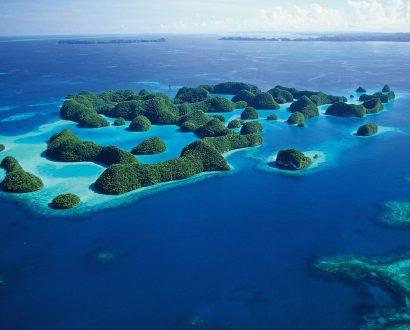Hidden gems around the world: Would you travel to these untouched destinations?

With iconic locations like Spain, France and the US brimming with snap-happy tourists, travel can often feel like an expensive and tiresome experience where all you’re doing is battling the crowds.
For this reason, an increasing number of globetrotters are ditching the hot spots in favour of the road less travelled.
In these lesser-known destinations, the food is more authentic yet less expensive, the hotels are often cheaper, and you’ll always find a spot on the beach.
In its annual Tourism Highlights 2017 report, the United Nations World Tourism Organization (UNWTO) found that international tourism has boasted mostly uninterrupted growth over time, with receipts earned by destinations worldwide surging from US$2 billion in 1950 to US$1,220 billion in 2016.
According to the report, these were the most popular countries in the world to visit in 2017:
- France: 82.6 million visitors
- United States: 75.6 million visitors
- Spain: 75.6 million visitors
- China: 59.3 million visitors
- Italy: 52.4 million visitors
- United Kingdom: 35.8 million visitors
- Germany: 35.6 million visitors
- Mexico: 35 million visitors
- Thailand: 32.6 million visitors
- Turkey: 30 million visitors
But what about the least visited countries?
On the other end of the spectrum, the UNWTO also unearthed the least visited countries that should be on every seasoned globetrotter's bucket list. We’re compiled a list of the top six untouched destinations and what you can expect to find if you venture off the beaten track and pay them a visit.
-
Tuvalu: 2,000 visitors
This tiny, remote South Pacific state has no armed forces, a low crime rate, and no political parties. In fact, most people hadn’t heard of it until the Duke and Duchess of Cambridge paid a visit back in 2012. Home to just 10,500 people spread over a total 16 square kilometres, it’s only accessible via a propeller plane or cargo/passenger ship from Fiji.

Sun-seeking travellers will delight in Tuvalu’s nine coral atolls, numerous coral reefs, lagoons and small islands perfect for swimming, diving and snorkelling. On land, enjoy a traditional friendly Polynesian culture known for its unique arts and crafts, music and dances.
-
Kiribati: 4,000 visitors
The isolated nation of Kiribati comprises 33 coral atolls dispersed over 3.5 million square kilometres in the central Pacific – making its islands relatively untouched and perfect for fishing, diving, boating and yachting.
Not only is it home to friendly ‘un-commodified’ locals and World War II remnants, but it also has the Phoenix Islands Protected Area – one of the largest marine protected areas in the world where visitors can explore coral reefs and discover hundreds of species of fish. But hurry, the islands are in danger of disappearing due to global warming.
-
Equatorial Guinea: 5,700 visitors
This Central African country is full of quaint colonial architecture, lush rainforests, volcanic views, and gorgeous white sand beaches. It’s divided into a mainland and five volcanic islands – including the popular Bioko Island, which features the country’s highest peak at over 3,000 metres high.
What Equatorial Guinea lacks in tourism infrastructure, it makes up for in chimps and gorillas, elephants, leopards, sea turtles, and hundreds of species of birds that call Monte Alen National Park home.
-
Marshall Islands: 6,000 visitors
Boasting more than 1,000 individual islands and islets, it comes as no surprise that the Marshall Islands are full of expert fishermen and navigators – and that it’s even home to the world’s largest shark sanctuary. We recommend a visit to Arno Atoll, nine kilometres from the capital Majuro, where you’ll find sandy white beaches and clear island waters.
However, be warned that the Marshall Islands are one of the most contaminated places in the world after being used as a nuclear testing zone by the US following World War II. On top of that, they’re also considered the most endangered destination in the world due to flooding from climate change.
-
Niue: 8,000 visitors
Located northeast of New Zealand in the middle of the South Pacific with just 1,000 inhabitants, Niue is one of the world’s largest coral atoll islands and also one of the smallest countries on Earth. It’s surrounded by protective coral reefs, limestone cliffs and scenic beaches – but below the surface lies high levels of natural radioactivity.
Outdoor tourist activities include cycling, diving and snorkelling, kayaking, fishing and golf and despite its remote the location, in 2003 Niue became the first nation in the world to provide free wi-fi across its entirety.
-
Sao Tome and Principe: 8,000 visitors
Africa’s least visited nation, this group of volcanic islands in the Gulf of Guinea are the definition of a lost tropical paradise. Rich in oil, cocoa and coffee plantations, volcanic rocks, clear warm waters and balmy afternoons, the slow-paced islands boast large stretches of tourist-free beaches just waiting to be explored.
Sao Tome provides world-class scuba diving, fishing and whale watching between July and October, while Obo National Park offers bird-watching, waterfalls, and the country’s tallest mountain – the 2,024-metre Pico de Sao Tome.
If you’re looking to tick off more unusual destinations on your bucket list, head to one of the ‘Blue Zones’ – the five regions in the world where people are living the longest and healthiest lives.